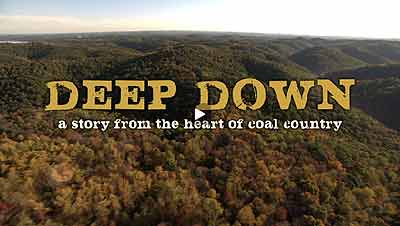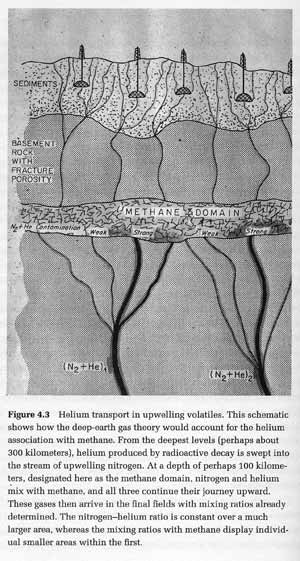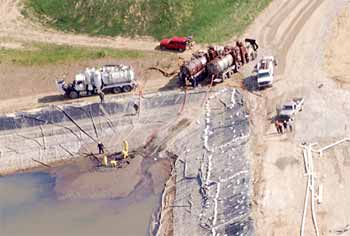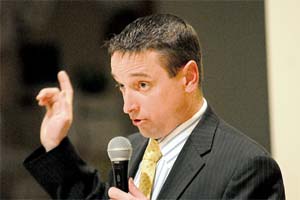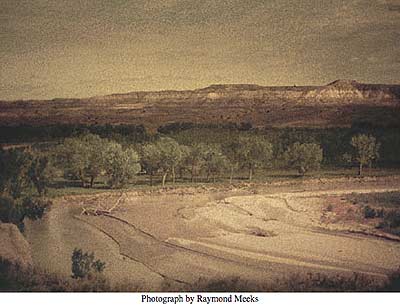Biblio
Damascus Citizens for Sustainability is a grassroots group in Damascus, PA. located within the Upper Delaware Basin Watershed.
Site includes excellent links to petition sites, working activist organizations, experts, environmental lawyers, blogs, photographs, and primary documents inlcuding transcripts to testimonials covering the brief history of gas drilling in the U.S.
See: Hearing Set to Shut Down Well Drilling in [Delaware River Basin] Watershed. January 19-26, 2011.
UPDATE: Damascus Citizens. December 16, 2010. e-mail correspondence.
Last week the gas industry withdrew from an important
hearing intended to challenge 14 "test wells" within
the Upper Delaware Watershed region.
The industry withdrew its multiple challenges to our
assertions of the inherent dangers to public health
posed by their drilling activities. At this time we
are reviewing our legal options...
Delaware RiverKeeper Network (DRN), Damascus Citizens for Sustainability (DCS) and Nockamixon Township are co-appellants in Consolidated Administrative Hearings before the Delaware River Basin Commission.
"Across vast regions of the country, gas companies are using a technology called hydraulic fracturing to produce natural gas from previously untapped beds of shale."
Fred R. Conrad/The New York TimesEnvironmental concern about hydraulic fracturing is creating political obstacles for gas drilling companies.
The most immediate hazard from the national drilling bonanza, it is clear, involves contamination of residential drinking water wells by natural gas. In Bainbridge, Ohio, an improperly drilled well contaminated groundwater in 2007, including the water source for the township’s police station, according to a complaint filed this year. After building to high pressures, gas migrated through underground faults, and blew up one house.
Here in Dimock, about 30 miles north of Scranton, Pa., 13 water wells, including that of Ms. Switzer, were contaminated by natural gas. One of the wells blew up.
Filmmaker Josh Fox of WaterUnderAttack.Com shows America how to speak truth to power, and leads us in the required revolution. "I know this is a farce, " he tells DEC at the public hearing they are required to do before shoving this crap down our throats. "You didn't listen to us before and you probably won't listen to us again. But we are willing to engage in civil disobedience."
See Gasland Trailer and See PBS interview with filmmaker Josh Fox.
See: Drilling Isn't Safe.
"I will start this story by saying that Aruba Petroleum has taken a great deal from my family, but they cannot take away our faith in God. This story may sound like one of defeat, but we are not defeated.
My husband Tim, daughter Reilly, and I purchased 10 acres and a wonderful home in Wise County, TX about six years ago. We thought that country life would be the best life for our daughter given her love of animals and nature. We have lived a peaceful life, improving our home when we could and striving to provide the best childhood possible for Reilly.
Aruba Petroleum turned that life upside down on August 29th 2009 with no regard for property or human health. We learned shortly after that day that our 10 acres were, unfortunately, a part of the 920 acre Wright lease held by Aruba Petroleum."
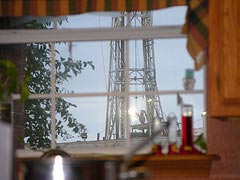
Beverly May and Terry Ratliff grew up like kin on opposite sides of a mountain ridge in eastern Kentucky. Now in their fifties, the two find themselves in the midst of a debate dividing their community and the world: who controls, consumes, and benefits from our planet's shrinking supply of natural resources?
While Beverly organizes her neighbors and leads a legal fight to stop Miller Brothers Coal Company from advancing into her hollow, Terry considers signing away the mining rights to his backyard-a decision that could destroy not only the two friends' homes, but the peace and environment surrounding their community.
Co-Director/Cinematographer
 JEN GILOMEN is Director of Public Media Strategies at the Bay Area Video Coalition (BAVC).
JEN GILOMEN is Director of Public Media Strategies at the Bay Area Video Coalition (BAVC).
Co-Director/Editor
See: Shnayerson, Michael. 2008. Coal River. 1st ed. Farrar, Straus and Giroux, January 8.
See: Robert F. Kennedy, Jr. Mobilizes on Mountaintop Removal
See: Marsh Fork Elementary: Journey Up Coal River | A Community and Strip Mining
See: Mountaintop Removal (Film)
See: Mike Roselle clip 2-from the Southern Regional Jail West Virginia
See: Tree spiker : from Earth First! to lowbagging: my struggles in radical environmental action
See: Leveling Appalachia: The Legacy of Mountaintop Removal Mining
Thomas Gold (1920-2004), Cornell astronomer and brilliant scientific gadfly.
The Abiogenic Theory of Petroleum Formation
Editor's Note: If we bust the myths about global warming and fossil fuels - the growing scarcity of our oil supply, and can replant lots of trees, by Freeman Dyson's estimates, a trillion, to remove all the carbon dioxide from the atmosphere now, with a lot more needed by 2050, as India, China, Brazil, etc. industrialize; then we only have to worry about methane from gas flares, and the melting of the tundra permafrost to prevent humanity from reaching the "tipping-point" of our destruction.
The Earth will undoubtedly survive, but we won't. Global Warming must be addressed by all governments, NGO's, citizen activists, and corporations. Drilling Isn't Safe. (Neil Zusman, 2010-11-14.)
Deep within the earth's crust there exists a second biosphere, composed of very primitive heat-loving bacteria and containing perhaps more living matter than is present on the earth's surface...
...Gold joins the deep hot biosphere argument to another, perhaps even more controversial theory for which he has marshalled evidence: that so-called fossil fuels originate not from compressed biological matter at all but from deep within the earth, present there since the planet's formation, long before our oxygen-rich surface biosphere came into existence.
The pattern of petroleum deposits and the mix of elements associated with them around the world, the dramatic results of a Swedish drilling project (1990) in non-sedimentary rock, and indications that some petroleum reserves are refilling - this is some of the evidence that supports Gold's thesis and cannot be adequately accounted for by conventional theories.
The implications of Gold's views are no less far-reaching than the theories behind them. The deep hot biosphere and deep-earth gas theories shed light on the nature of earthquakes, they suggest that reservoirs of petroleum and certain metal ores are much vaster (though not necessarily more accessible) than generally claimed, and they help to answer two of the most profound mysteries of the biological sciences: the origins of life on earth and the prospects of extraterrestrial life.
Did life develop from the deep hot biosphere? Are Mars and other planets as lifeless as they seem, or might they too be found to contain deep hot biospheres, if only scientists would look below the surface. --from the book jacket, 1999 edition.
Chapter 4. Evidence for Deep-Earth Gas
Chapter 5. Resolving the Petroleum Paradox
Chapter 6. The Siljan Experiment
Schematic image showing how the deep-earth gas theory would account for the helium association with methane (p. 76). Perhaps drilling deeper would make hydraulic fracturing and mountain-top removal unnecessary.
Gold's book has a Foreword by Freeman Dyson who is among the signatories of a letter to the UN criticizing the IPCC. He has argued against the ostracization of scientists whose views depart from the acknowledged mainstream of scientific opinion on climate change, stating that "heretics" have historically been an important force in driving scientific progress."
Heretics who question the dogmas are needed... I am proud to be a heretic. The world always needs heretics to challenge the prevailing orthodoxies."
See: Nicholas Davidoff. NYT. 2009. "The Civil Heretic".
See: Freeman Dyson. Heretical Thoughts About Science and Society. Edge | The Third Culture. Aug. 8, 2007.
See: Kellesidis, V.C. (2009). Challenges for very deep oil and gas drilling-will there ever be a depth limit? Athens, Greece: 3rd AMIREG International Conference (2009): Assessing the Footprint of Resource Utilization and Hazardous Waste Management.
Of course, we find oil ‘where it is’, where it has remained for ages, but how was it formed? Current belief is that oil is of biotic origin, through accumulation of organic matter (plankton, single cell organisms that floated on ocean surface) and sedimentation followed by burial. For large periods organic material has been under very high pressures and temperatures, in the range of 130-150 degrees C, in a ‘cooking pot’ and gradually transformed to petroleum.
Because of its lower density, it has migrated upwards and some surfaced and was lost, while some has hit non-permeable layers (the seal) and accumulated in the porous sedimentary rocks creating the world’s oil and gas fields.
There is, however, another school of thought, not very well known until recent years, which is gaining, though, momentum. It is the theory of abiotic (or abiogenic) origin of petroleum, that hydrocarbons have been formed in the depths of earth by reduction of CO2 and H2 gases in the presence of metal catalysts (Gold and Soter, 1980; Kenney, 1994; Krayushkin et al., 1994; Glasby, 2006; Wikipedia, 2009).
The consequences of course of such a theory, if true, could be extraordinary, as earth’s mantle becomes the inexhaustible provider of the cheapest energy source on earth...
Alexandrovich Kudryavtsev (Kudryavtsev, 1951) was the first to start the theory of abiotic generation of hydrocarbons, in what has become the modern Russian-Ukrainian theory of abyssal, abiotic petroleum (Kropotkin, 1986; Kenney et al., 2002). However, Abbas (1996) starts the history as early as 1877 by Mendeleev and provides a good overview as well as pros and cons about the two points of view.
See: Jet Propulsion Laboratory, California Institute of Technology. Beautiful Ontario Lacus: Cassini’s Guided Tour.
Ontario Lacus, the largest lake in the southern hemisphere of Saturn’s moon Titan, turns out to be a perfect exotic vacation spot, provided you can handle the frosty, subzero temperatures and enjoy soaking in liquid hydrocarbon.
See these articles:
Bluemle, J., and L. Manz. 2004. The Origin of Oil. North Dakota Department of Mineral Resources: North Dakota Feological Survey. NDGS Newsletter. 31: 1. Summer 2004.
Glasby, G. P. 2006. Abiogenic origin of hydrocarbons: An historical overview. Resource Geology 56, no. 1: 83–96.
Gold, Thomas. 1982. Abiogenic methane and the origin of petroleum. Energy Exploration & Exploitation 1, no. 2: 89–104.
———. 1992. The deep, hot biosphere. Proceedings of the National Academy of Sciences of the United States of America 89, no. 13: 6045.
———. 1993. The Origin of Methane (and Oil) in the Crust of the Earth. USGS Professional Paper 1570.
U.S. Department of the Interior | U.S. Geological Survey (USGS). 1998. OFR 98-468 World Conventional Crude Oil and Natural Gas. U.S. Geological Survey (USGS).
Shale gas drilling is looming in the Upper Delaware River Watershed in NY and PA.
Why is this a threat to our water supplies?
What are the risks involved ?
Established in 1988 upon the appointment of the Delaware Riverkeeper, the Delaware Riverkeeper Network (DRN) is a nonprofit 501(c)(3) membership organization. DRN's professional staff and volunteers work throughout the entire Delaware River Watershed including portions of Pennsylvania, New Jersey, Delaware and New York.
See Delaware River Keeper. (2009). "Natural Gas Well Drilling and Production in the Upper Delaware River Fact Sheet".
"...An increased risk of stillbirths linked to the flaring of natural gas with high levels of hydrogen sulfide has been reported in cattle in Canada. Incidents in Texas are increasingly reported, especially in the Fort Worth region.
There is a need for thorough study of the environmental and health impacts of well drilling and development; there is very little on record. For instance, in Colorado a Health Impact Assessment has been called for as part of an Environmental Impact Statement due to documented pollution problems from natural gas development in Garfield County that require scientific analysis.
To date, research has been impeded because fracking fluids are protected from disclosure by federal protections granted to the oil and gas industry despite health and environmental impacts..."
"It is estimated that more than 5 million gallons of water per day are used in fracturing operations." ( p. 26 of 34. )
This 2006 Powerpoint may represent the only scholarly study found to date that indicates an accurate estimate of the amount of water used per day in hydrofracking. Further research into this estimated amount is required.
Presented at “The Future of Desalination in Texas,” Global Petroleum Research Institute, Texas A&M University, College Station, Texas, Aug. 6-8, 2006.
Pennsylvania's natural gas drillers are still flushing vast quantities of contaminated wastewater into rivers that supply drinking water, despite major progress by the industry over the past year in curtailing the practice.
Photo: marcellus-shale.us
Under pressure from environmentalists and state officials, energy companies that have been drilling thousands of gas wells in the state's countryside spent part of 2010 overhauling the way they handle the chemically tainted and sometimes radioactive water that gushes from the ground after a drilling technique known as high-volume hydraulic fracturing, or fracking.
Until the second half of last year, Pennsylvania had been the only state to allow most of this wastewater to be discharged into rivers after only partial treatment. Other states required most or all of the brine to be disposed of by injecting it deep underground.
In recent months, though, the industry has boasted big gains in the amount of well wastewater that is reused, rather than trucked to treatment plants that empty into rivers and streams.
See: Articles on Fracking waste water.
See: Pittsburgh’s drinking water is radioactive, thanks to fracking. Only question is, how much?
Daniel Gilbert. "Underfoot, Out of Reach: A series on the conflicts over Southwest Virginia's natural gas wealth." Virginia Tri-Cities.com. (online).
Beneath the surface of seven Southwest Virginia counties lie pools of natural gas worth more than a billion dollars a year. Some of this gas belongs to landowners forced by the state to lease their mineral rights to private energy corporations to develop. But instead of putting royalties into the pockets of mineral owners, the state funnels thousands of dollars every month into an escrow fund that royalty owners cannot monitor or access without clearing enormous legal hurdles.
While the system has vastly expanded production of natural gas in Virginia, it has devoted scant resources to ensuring that companies make the required payments into escrow, which in recent years has ballooned to more than $24 million. The result is that companies can produce gas for years without ever filing the necessary paperwork for royalties to be escrowed, and virtually no one notices that hundreds of individual accounts in escrow each month receive no deposits even though the corresponding gas wells are producing gas, a Bristol Herald Courier investigation finds.
To view the special program "The Paper that Made a Difference", produced by WJHL 11Connects, click here for part one, and here for part two of the program.
Articles in this series:
Part Three: The Virginia Supreme Court Weighs In
Part Four: Coal Goes on the Offensive
Part Five: From Crisis to Sustained Loss
Part Six: What is Missing from Escrow?
Part Seven: An Audit Long Delayed
Part Eight: Sue, Split or Do Nothing
Dig Deeper:Resources and links for more information
Do I have money in escrow? How to use our database and determine if you may have money in escrow.
View the members of and contact information for the Virginia Gas and Oil Board
Graphics:
Hydraulic Fracturing
Bristol Herald Courier
How Forced Pooling works
Search our Database for information on escrow accounts, with balances each month, current to March 2010.
See: Tom Vanderbilt. "Paper Trail." Time. Feb. 14, 2011.
Natural gas drilling in the Marcellus Shale Formation is threatening our health, and our water quality. Local resident gives her account of drilling in her community.
What the heck am I looking at?
We've created maps of political campaign contributions from companies in the oil & gas and coal industries to congressional representatives. These are relationship map of the contribution network. That means that unlike a physical map, where points are positioned at a geographic location, the icons for the companies and representatives are placed so that they are as close as possible to whomever they contribute to or receive contributions from.
Think of it like a social networking site in which companies and politicians have become 'friends' by giving money.
This site is a project of Oil Change International, developed by Greg Michalec and Skye Bender-deMoll and designed by Diligent Creative. Earlier versions of the site were named 'Follow the Oil Money' and 'Follow the Coal Money'.
The Mayor of tiny Dish, Texas, north of Fort Worth, continues to stir up controversy with his claims of air pollution from oil and gas activities causing health concerns in his community. The mayor appeared at the RRC's January 12 open hearing. You can watch his testimony here (go to item 17 on the agenda).
The mayor's appearance was prompted by an item placed on the agenda by Commissioner Michael Williams, which in turn had been prompted by a letter sent to the Commissioners by State Rep. Ron Burnam. Rep. Burnam's letter asked the RRC to place a moratorium on permits for wells in the Barnett Shale around Fort Worth until the Texas Commission on Environmental Quality (TCEQ) has finished its investigation of air quality in the area.
In response, Commissioner Williams proposed that the Commissioners write a letter to the Texas Attorney General asking for a formal opinion whether the RRC has authority to issue such a moratorium. (Rep. Burnam has also asked the City of Fort Worth to issue a similar moratorium on well permits in the city limits.) I have written about the controversy concerning the town of Dish in a previous post.
John McFarland is a shareholder at Graves, Dougherty, Hearon & Moody in Austin Texas specializing in representation of landowners and mineral owners in oil and gas matters in Texas.
See: Health Issues Follow Natural Gas Drilling In Texas
See: How Should We Do the Mountain?: Who the heck is Calvin Tilman?
Powder Keg
The gas industry has been busy in Wyoming's prairies and grasslands, building thousands of miles of roads and sinking more than 10,000 wells in the past three years. But in the Powder River basin, ranchers are joining environmentalists to try to still the drills.
See: C-Span Book TV Oct. 2, 2004. Bushwacked: Life in George W. Bush's America. Chapter: "Dick, Dubya, and Wyoming Methane." (152)
Created Sep 15, 2010 by Kyle Ferrar
This map shows the multitude of surface water withdrawals in Pennsylvania that are permitted by the PA DEP. The many points exemplify the magnitude that the PA community and economy relies on the quality of our surface water resources. The red stars show the oil and natural gas industry withdrawal locations.
Click to see more details on this map.
The current water management practices of the natural gas industry during the regional dry season are likely to have contributed to higher TDS concentration in the Monongahela River...
...the water withdrawals in the Monongahela River watershed are potentially causing a cumulative impact on flow volume in the river that magnifies all forms of pollution by increasing the pollutant concentrations. Much more research needs to be conducted on this issue, to ensure safe and sustainable permitting practices for water withdrawals.
See: Urbina, Ian. “Regulation Is Lax for Water From Gas Wells.” The New York Times 26 Feb. 2011. Web. 27 Feb. 2011.
See: With Natural Gas Drilling Boom, Pennsylvania Faces an Onslaught of Wastewater
See: WATER: Gas drilling in huge Appalachia reserve yields foul, briny byproduct - AP













